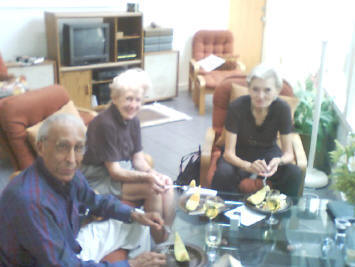|
The Greatest
Generation Reunites
by Verne Woods
Verne walked away away from Stalag Luft I before the
B-17s arrived to evacuate everyone. Just one of his 15 roommates joined
him on the trip to the British Lines. Tom Brokaw's "The Greatest
Generation Speaks" book recently led to him finding that roommate after
50 years.
Let me tell of an occurrence, still ongoing, that began several weeks
ago. It started when a friend living in Pittsburgh sent me an E-Mail
asking if I'd known a Miguel Encinias in Stalag Luft I. My Pittsburgh
friend had just finished reading Tom Brokaw's "The Greatest Generation
Speaks" in which Encinias, a fighter pilot who'd been shot down over
Italy, is profiled. The book in which his story is told is a sequel to
Brokaw's earlier best seller, "The Greatest Generation."
I wrote back to tell my friend that Stalag Luft I contained some 9000
British, Canadian and American airmen, that there were 1500 men in my
compound, North Compound I, that there were 120 men in my barracks and
16 men in my room. Mike Encinias, I said, was one of those 16. I then
went on to tell him of a quite memorable episode involving Mike that
occurred in the wake of our camp's liberation.
After the Russians swept through the area on May 1, 1945, the camp had
only limited contact with American authorities for the next several
days. We became fearful that the Russians might have some ulterior
motive in delaying our evacuation. (Years later I was to learn that this
was indeed the case. The Russians told the American authorities that
they planned to march all the Stalag Luft I prisoners to the Black Sea
port of Odessa where they would evacuated by ship.) On the fifth night
after our liberation, my 15 roommates and I, lounging on our bunks in
the dark, took up the question: "Should we leave the camp and walk to
the British lines 100 miles to the West?"
But simply walking out of the camp wasn't that straight forward. On the
first day of the camp's liberation, following our wild foray into town
and surrounding countryside, several POWs had been killed either by the
Russians or German civilians. As a consequence, our camp commander,
Colonel Zemke, had forbidden anyone to leave the camp and had, in fact,
placed American guards, armed with German rifles from the camp arsenal,
in the towers to assure that no one left.
So in addressing the question of whether or not we should leave for the
British lines, we had to take into consideration the possibility of
being shot by our own guards. We all decided that there was no chance at
all that one of our own POWs would shoot a fellow POW. Anyway, we
probably wouldn't be seen at night because there was no electricity and
thus the tower searchlights weren't operating. After we'd all agreed
that we should walk out the next question was "when?"
I spoke up. Right now, I said. There was silence. Only one person was
willing to join me. It was Mike Encinias who said let's go. There was no
one else. I was sure someone else in the room would join us as we packed
food and possessions in a bundle getting ready to leave. But no one did.
We bid everyone a quick, unceremonious good-bye and walked out of the
camp unchallenged through a big gap that the POWS had made in the fence
on that first day of liberation.
We reached the British lines two days later without incident and were
flown to England the next day. Mike and I were living it up in London
for a week before the difficulties with the Russians were resolved and
B-17s from the 91st Bomb Group were flown in to evacuate the prisoners
of Stalag Luft I. During that time together in London I came to know
Mike quite well -- better, in fact, than I had known him during those 17
months of obliged intimacy. Later, after the war, when my wife and I
were attending the University of Iowa under the GI bill, Mike visited us
there in Iowa City. I scanned a picture of Mike taken during that Iowa
visit and E-mailed it to my friend in Pittsburgh.
|
 |
|
Miquel Encinias - 1948 |
Then I immediately went to the bookstore and bought "The Greatest
Generation Speaks." In it, I learned that Mike had remained in the Air
Force, had flown 65 missions in P-51s and F-86's during the Korean War.
There, he was again shot down but was rescued by helicopter and thus
avoided being captured again. Later, he went on to fly still more
combat missions in Viet Nam. I also learned that Mike had returned to
college and had earned a Ph.D. After retiring from the Air Force, he has
worked to improve conditions in the New Mexico Hispanic community.
When I finished reading about him in the Brokaw book, I tried to find
his E-mail address but without success. So I sent a postage letter to a
Miquel Encinias in Albuquerque, NM, hoping that this would be the Mike
Encinias who had been my Stalag Luft I roommate. Viola! Miguel Encinias
was indeed Mike Encinias. Several days after posting my letter the
phone rang and it was Mike from New Mexico. We talked for two hours. I
learned that he is on the World War II Memorial Commission (the
Commission planning the WWII memorial which will have a place beside the
Viet Nam memorial on the Washington Mall) and that when the Commission
has its next meeting he will use that occasion to visit my wife and me
here in Massachusetts.
 |
Reunited after 53 years.
Mike and his wife Jeannine came to visit Verne and Onie Woods in
August 2001.
L to R: Mike Encinas, Onie Woods and Jeannine Encinas
|
|
